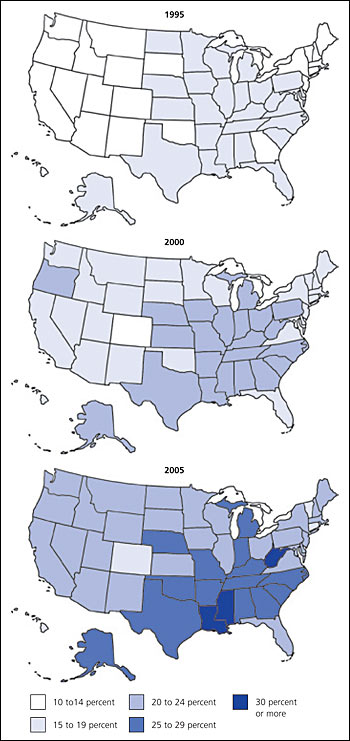
Am Fam Physician. 2007;75(12):1885
CDC Releases Report on Prevalence of Adult Obesity
Source: Centers for Disease Control and Prevention
Published source: Morbidity and Mortality Weekly Report, September 15, 2006
Obesity is linked with a higher risk of hypertension, dyslipidemia, type 2 diabetes, coro-nary heart disease, stroke, and some cancers. One goal is to reduce the prevalence of obesity in adults by 15 percent. To analyze the prevalence of obesity by state, the Centers for Disease Control and Prevention (CDC) evaluated data from the 1995, 2000, and 2005 Behavioral Risk Factor Surveillance System surveys.
Adults with a body mass index (BMI) of 25 kg per m2 or more were classified as as overweight, a BMI of 30 or more as obese, and a BMI of 40 or more as extremely obese. In 2005, approximately 60 percent of adults were overweight, 24 percent were obese, and 3 percent were extremely obese. Overall, 24.2 percent of men and 23.5 percent of women were obese, and 17.7 percent of persons 18 to 29 years of age and 29.5 percent of persons 50 to 59 years of age were obese. The highest obesity rate (33.9 percent) was in non-Hispanic blacks. After adjusting for age, obesity prevalence was 15.6 percent in 1995, 19.8 percent in 2000, and 23.7 percent in 2005.
The CDC found that the prevalence of obesity increased significantly (P < .01) from 1995 to 2005 in all states. From 1995 to 2000, the number of states with a less than 20 percent obesity rate dropped from 50 to 28 (Figure 1). In 2005, only four states had an obesity rate of less than 20 percent. Seventeen states had an obesity rate of 25 percent or more, and three of these had a rate of 30 percent or more. To reverse this trend, an effective public health response is needed, including programs aimed at improving environmental factors, increasing awareness, and changing behaviors.
